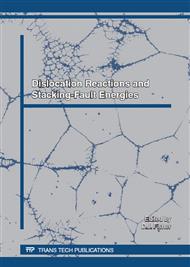[1]
Skinner, S. J., Kilner, J. A., Materials Today (2003).
Google Scholar
[2]
Knauth, P., Tuller, H. L., Journal of the American Ceramic Society, 85 (2002) 1654-1680.
Google Scholar
[3]
Boivin, J. C., Mairesse, G., Chem. Mater.,. 10 (1998) 2870-2888.
Google Scholar
[4]
Goodenough, J. B., Ceramic Technology, Oxide ion Conductors by design, news and views.
Google Scholar
[5]
Steele, B. C. H., Solid State Ionics, 1223 (1996) 86-88.
Google Scholar
[6]
Boumeester, H. J. M., Burgraff, A. J., The Fundamentals of Inorganic Membrane Science and Technology, Ed. By Burgraff, A. J., Cot, L., (Elsevier, Amsterdam, 1996. ).
Google Scholar
[7]
Doshi, R., Routbort, J. L., Alcock, C. B., Defect and Diffusion Forum, 39 (1996) 127.
Google Scholar
[8]
Tuller, H. L., Journal of the Physics and Chemistry of Solids, 55 (1994) 1393.
Google Scholar
[9]
Kendall, K. R., Navas, C., Thomas, J. K., Zurloye, H. C., Solid State Ionics, 82 (1995) 215.
Google Scholar
[10]
Gellings, P. J., Boumeester, H. J. M.,. Catalysis Today, 12 (1992) 1.
Google Scholar
[11]
West, A. R., 1991. J. Mater. Chem., 1 (1991) 157.
Google Scholar
[12]
Murch, G. E., Nowick, A. S.,. Diffusion in Crystalline Solids (Academic, New York, 1984).
Google Scholar
[13]
Saiful, M., J. Mater. Chem., 10 (2000) 1027.
Google Scholar
[14]
Beg, S., Sarita, Varshney, P., Phase Transitions, 80 (2007) 867-873.
Google Scholar
[15]
Badwal, S. P. S., Solid State Ionics, 52 (1992) 23.
Google Scholar
[16]
Badwal, S. P. S., Drennan, J.,. in Science of ceramic interfaces II edited by Nowotny, J.; (Elsevier science, Amsterdam, 1994) 71.
Google Scholar
[17]
Lamas, D. G., Walsoe De Reca, N. E., J. Mater. Sci., 35 (2000) 5563.
Google Scholar
[18]
Garvie, R. C., Hannink, R. H. J., Pascoe, R. T., Nature, 258 (1975) 703.
Google Scholar
[19]
Lee, W. E., Rainforth, W. M.,. Ceramics Microstructures property control by processing (Chapman and Hall, London, 1994), 317.
Google Scholar
[20]
Frey, F., Boysen, H., T. Vogt, T., Acta Crystallographica B, 46 (1990) 724.
Google Scholar
[21]
Subbarao, E. C., Maiti, H. S., Srivastav, K. K., Physica Status Solidi A, 21 (1974) 9.
Google Scholar
[22]
Smith, D. K., Newkrik, H.,. Acta Crystallographica, 18 (1965) 983.
Google Scholar
[23]
Beg, S., Ahmad, A., Sarita, Varshney, P., Colloid Chemistry and Electrochemistry, Russian Journal of Physical Chemistry, 80 (2006) 1141-1145.
DOI: 10.1134/s0036024406070247
Google Scholar
[24]
Kilner, J. A., Solid State Ionics, 129 (2000) 13.
Google Scholar
[25]
Beg, S., Sarita, Varshney, P., Chinese Journal of Chemistry, 25 (2007) 1-10.
Google Scholar
[26]
Nakamoto, K., Infrared and Raman spectra of inorganic and coordination compounds, John Wiley and sons, III edition, (1990).
Google Scholar
[27]
Zaki, H. M., Mansour, S. F., Journal of Physics and Chemistry of Solids, 67 (2006) 1643.
Google Scholar
[28]
Powder Diffraction file No. 040569.
Google Scholar
[29]
Bondioli, F., C. Leonelli, C., Manfredini, T., Journal of the American Ceramic Society, 88 (2005) 633.
Google Scholar
[30]
John, J. R., Kim, J. G., Kwon, T. D., Park, E. H.,. Characterization of Titanium Sulphate supported on Zirconia, Langmuir, 18 (2002) 1666.
Google Scholar
[31]
Dygas, J. R., Malys, M., Krok, F., Wrobel, W., Kozanecka, A., Abrahams, I., Solid State Ionics, 176 (2005) (2085).
DOI: 10.1016/j.ssi.2004.12.017
Google Scholar
[32]
Godinho, M. J., Bueno, P. R., Orlandi, M. O., Leite, E. R., Long, E., Materials Letters, 57 (2003) 2540.
Google Scholar
[33]
Rao, C. N. R., Rao, K. J., Phase Transitions in Solids, (McGraw Hill. New York, 1978), 263.
Google Scholar
[34]
Kumari, M. S., Secco, E. A., Canadian Journal of Chemistry, 56 (1978) 2616.
Google Scholar
[35]
Kumari, M. S., Secco, E. A., Canadian Journal of Chemistry, 63 (1985) 324.
Google Scholar
[36]
Nair, S. M., Yahya, A. I., Ahmad, A., Journal of Solid State Chemistry, 122 (1996) 349.
Google Scholar
[37]
Gao, L., Liu, Q., Hong, J. S., et al., Journal of Materials Science, 33 (1998) 1399.
Google Scholar
[38]
Acharaya, S. N., Mathews, M. D., Patwe, S. J., Tyagi, A. K., Journal of Materials Science, 18 (1999) 355.
Google Scholar
[39]
Wrobel, W., Abrahams, I., Krok, F., Kozanecka, A., Chan, S. C. N., Malys, M., Bogusz, W., Dygas, J. R., Solid State Ionics, 176 (2005) 1731.
DOI: 10.1016/j.ssi.2005.04.024
Google Scholar


